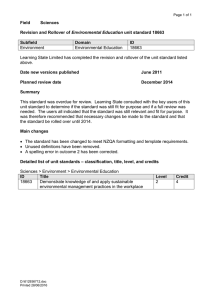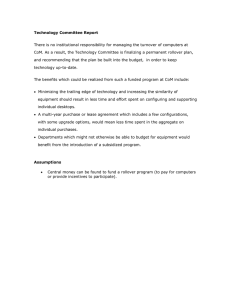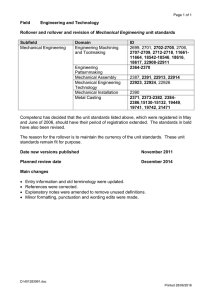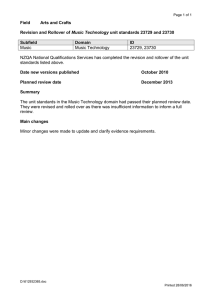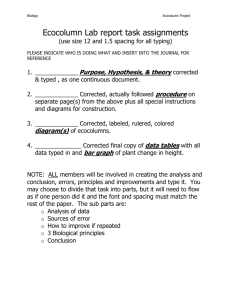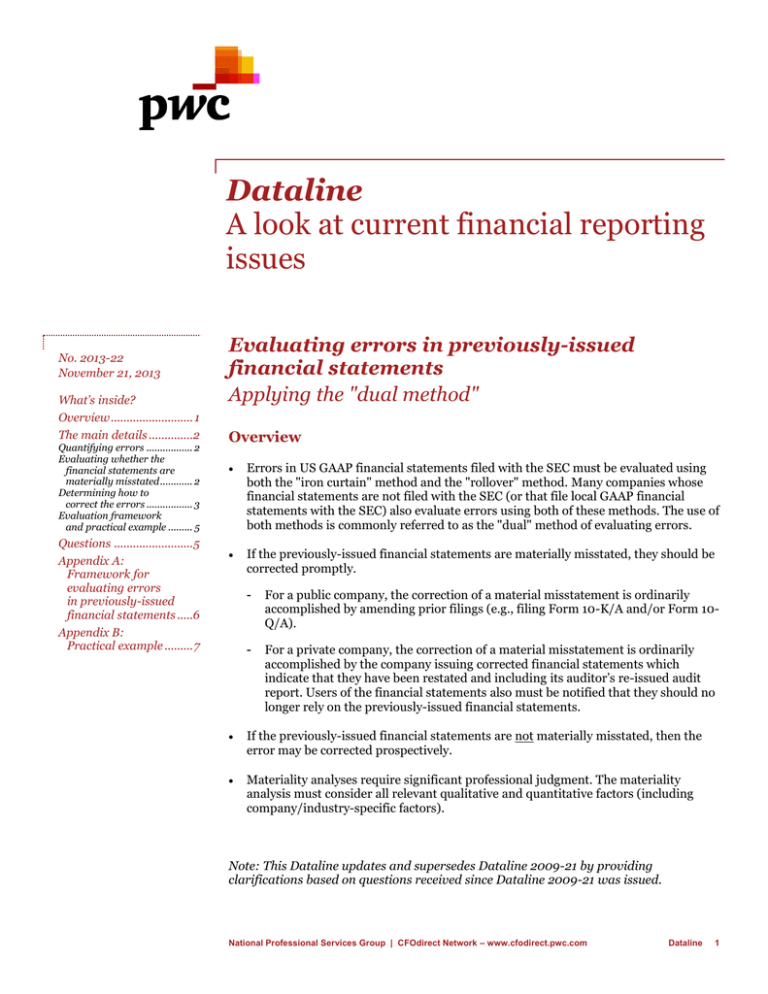
Dataline
A look at current financial reporting
issues
No. 2013-22
November 21, 2013
What’s inside?
Overview .......................... 1
The main details ..............2
Quantifying errors ................. 2
Evaluating whether the
financial statements are
materially misstated ............ 2
Determining how to
correct the errors ................. 3
Evaluation framework
and practical example ......... 5
Questions ......................... 5
Appendix A:
Framework for
evaluating errors
in previously-issued
financial statements .....6
Appendix B:
Practical example ......... 7
Evaluating errors in previously-issued
financial statements
Applying the "dual method"
Overview
Errors in US GAAP financial statements filed with the SEC must be evaluated using
both the "iron curtain" method and the "rollover" method. Many companies whose
financial statements are not filed with the SEC (or that file local GAAP financial
statements with the SEC) also evaluate errors using both of these methods. The use of
both methods is commonly referred to as the "dual" method of evaluating errors.
If the previously-issued financial statements are materially misstated, they should be
corrected promptly.
-
For a public company, the correction of a material misstatement is ordinarily
accomplished by amending prior filings (e.g., filing Form 10-K/A and/or Form 10Q/A).
-
For a private company, the correction of a material misstatement is ordinarily
accomplished by the company issuing corrected financial statements which
indicate that they have been restated and including its auditor’s re-issued audit
report. Users of the financial statements also must be notified that they should no
longer rely on the previously-issued financial statements.
If the previously-issued financial statements are not materially misstated, then the
error may be corrected prospectively.
Materiality analyses require significant professional judgment. The materiality
analysis must consider all relevant qualitative and quantitative factors (including
company/industry-specific factors).
Note: This Dataline updates and supersedes Dataline 2009-21 by providing
clarifications based on questions received since Dataline 2009-21 was issued.
National Professional Services Group | CFOdirect Network – www.cfodirect.pwc.com
Dataline
1
The main details
Quantifying errors
.1 When errors in previously-issued financial statements are identified, they must be
assessed to determine whether the affected financial statements are materially misstated.
The starting point for any materiality analysis is to quantify the errors. SEC Staff
1
Accounting Bulletin No. 108 (SAB 108) provides guidance to consider when quantifying
errors.
.2 SAB 108 requires that errors be evaluated under both the "rollover" method and the
"iron curtain" method. The principal difference between these two methods lies in how
income statement errors are quantified.
The "rollover" method quantifies income statement errors based on the amount by
which the income statement is actually misstated — including the reversing effect of
any prior errors. Identified misstatements in the previous period that were not
corrected need to be considered to determine the "carryover effects".
The "iron curtain" method quantifies income statement errors based on the amount
by which the income statement would be misstated if the accumulated amount of
the errors that remain in the balance sheet were corrected through the income
statement of that period.
PwC observation:
The above discussion is focused on how the "rollover" and "iron curtain" methods are
applied when evaluating materiality with respect to the financial statements.
However, it is important to note that the quantified materiality of an error must be
evaluated with respect to each affected financial statement, as well as the impact on
financial statement line items and financial statement disclosures. For instance, in
addition to considering the income statement, a materiality evaluation under the
"rollover" method would also include consideration of whether any cumulative
unadjusted error(s) in the balance sheet(s) resulted in a material misstatement of the
balance sheet(s) or the statement(s) of stockholders' equity. Similarly, the evaluation
under the "rollover" method for each impacted period would include consideration of
whether the rollover impact of the error(s) would materially impact the statement(s)
of cash flows or disclosures.
Evaluating whether the financial statements are materially misstated
.3 After the errors have been quantified, the previously-issued financial statements
should be evaluated to determine whether they are materially misstated. SEC Staff
Accounting Bulletin No. 99 (SAB 99) provides guidance to consider when evaluating
materiality.
.4 SAB 99 should be used as a "guide" rather than a "checklist." Not all of the factors in
SAB 99 are relevant to every situation. Additionally, some factors that are relevant to the
analysis may not be specifically listed in SAB 99 (e.g., industry-specific considerations).
All relevant qualitative and quantitative factors (including company-specific factors)
must be considered. Materiality analyses require significant professional judgment.
1
Codified in ASC 250-10-S99 SEC Materials
National Professional Services Group | CFOdirect Network – www.cfodirect.pwc.com
Dataline
2
.5 In a December 2008 speech, an Associate Chief Accountant in the SEC's Office of the
2
Chief Accountant clarified the SEC staff's view of how SAB 108 should be applied to
previously-issued financial statements. The Associate Chief Accountant indicated that if
the effect of a correction would not materially affect the previously-issued financial
statements, those financial statements may still be relied upon, and the correction may
be made in future filings (i.e., without requiring an amendment to prior filings).
If the errors are material when evaluated under the "rollover" method, then the
previously-issued financial statements are considered materially misstated (i.e.,
they should no longer be relied upon).
If the errors are not material when evaluated under the "rollover" method, then the
previously-issued financial statements are not considered materially misstated (i.e.,
they can continue to be relied upon). However, if the impact of the errors to the
current period financial statements would be material when evaluated under the
"iron curtain" method, then the errors need to be corrected even though the
previously-issued financial statements are not materially misstated.
PwC observation:
When considering whether previously-issued financial statements are materially
misstated, the key principle to focus on is whether the corrected financial statements
would be materially different from the previously-issued financial statements. The
"rollover" method is used to evaluate whether previously-issued financial statements
are materially misstated. The "rollover" method is used because, as discussed above,
the "rollover" method quantifies the actual financial statement errors for each period.
If an error is not material to previously-issued financial statements under the
"rollover" method, then those financial statements can continue to be relied upon.
Errors evaluated under the “rollover” method are compared to the “as reported”
amounts in previously-issued financial statements.
The "iron curtain" error analysis does not drive the decision regarding whether or not
previously-issued financial statements are materially misstated. The error in the
previously-issued financial statements should be quantified and evaluated under the
"iron curtain" method to determine how the error needs to be corrected. In other
words, if an error in previously-issued financial statements is not material under the
"rollover" method, but would be material under the "iron curtain" method, then the
error must be corrected by revising the previously-issued financial statements the
next time they are filed. An error that would be material to the previously-issued
financial statements under the "iron curtain" method cannot remain as an unadjusted
difference.
Determining how to correct the errors
.6 Once the materiality analysis is complete, the company must determine how to
correct the errors.
Correcting financial statements that are materially misstated
.7 If the previously-issued financial statements are materially misstated (under the
"rollover" method), then they should be corrected promptly. For a public company, the
correction of a material misstatement is ordinarily accomplished by amending prior
filings (e.g., filing Form 10-K/A and/or Form 10-Q/A). For a private company, the
2
http://www.sec.gov/news/speech/2008/spch120808mm.htm
National Professional Services Group | CFOdirect Network – www.cfodirect.pwc.com
Dataline
3
correction of a material misstatement is ordinarily accomplished by the company issuing
corrected financial statements which indicate that they have been restated.
The corrected financial statements should include the disclosures required by ASC
250, Accounting Changes and Error Corrections. These disclosures include the
nature of the error and the quantitative effects of correction on each affected
financial statement line item (including per share amounts). Affected column
headings should be labeled "Restated" (or something comparable).
An audit report on the corrected financial statements should include an explanatory
paragraph indicating that the previously-issued financial statements have been
restated to correct a misstatement. The explanatory paragraph should also include a
reference to the company's disclosure of the correction. Refer to PCAOB AU 508,
paragraphs 18A-18C or AICPA AU 420.12 (as appropriate) for the audit reporting
requirements.
Business entities may present historical, statistical-type summaries of financial data
for a number of periods—commonly 5 or 10 years. Whenever error corrections have
been recorded during any of the periods included, a quantitative and qualitative
analysis of the error should be performed for these years.
Management should consult with its counsel to determine the appropriate steps and
timing for providing notice that the materially misstated financial statements
should no longer be relied upon (e.g., by filing a Form 8-K under Item 4.02). The
auditor should consider the guidance in PCAOB AU 561 or AICPA AU-C 560 (as
appropriate).
Management and/or the auditor should also consider how the error impacts their
respective conclusions regarding internal control over financial reporting and/or
disclosure controls and procedures, as appropriate. This analysis of the control
implications should be for the current and prior period end.
Correcting financial statements that are not materially misstated
.8 If the previously-issued financial statements are not materially misstated, then the
errors may be corrected prospectively. Prospective correction may be accomplished in
one of two ways (depending on the circumstances).
3
Correction as an "out-of-period" adjustment: Errors may be corrected as an "outof-period" adjustment if the correction would not result in a material misstatement
of the estimated income/loss for the year in which the adjustments are made or to
the trend in earnings. This is true even if the "out-of-period" adjustment is material
to the interim financial statements in which it is recorded unless the error
originated in the current year. An "out-of-period" adjustment that is material to the
interim financial statements in which it is recorded (but not material with respect to
the estimated income for the full fiscal year or to the trend of earnings) should be
3
separately disclosed (in accordance with ASC 250-10-45-27 ).
Revising financial statements the next time they are filed: If the errors cannot be
corrected as an "out-of-period" adjustment without causing a material
misstatement of the estimated income/loss for the year in which the adjustment is
made or to the trend in earnings, then the errors must be corrected by revising the
previously-issued financial statements the next time they are filed (e.g., for
comparative purposes). This is commonly termed as a “revision” of previouslyissued financial statements. The revised financial statements should include
Pre-codification APB 28, Interim Financial Reporting, paragraph 29
National Professional Services Group | CFOdirect Network – www.cfodirect.pwc.com
Dataline
4
transparent disclosure regarding the nature and amount of the errors being
corrected. The disclosure should provide insight into how the errors affect all
relevant periods. For instance, if the first filing to be corrected is a Form 10-Q,
management should consider disclosing how the error will affect all interim and
annual periods that will ultimately be revised.
PwC observation:
Management should consult with its counsel to determine whether the company
should provide disclosure of prospective corrections (other than in the financial
statements that reflect the prospective correction). We do not believe it would
ordinarily be necessary to file a Form 8-K under Item 4.02 because the previouslyissued financial statements are not materially misstated (i.e., they can continue to be
relied upon). However, there may be other situations in which separate disclosure
would be appropriate. For instance, if securities are to be offered based on the
uncorrected financial statements, the prospectus/offering materials may need to
include additional disclosure (including quantification) of the impending correction.
We do not believe an auditor’s report on the revised financial statements would need
an explanatory paragraph referring to the revision (although dual date may be
required as described in PCAOB AU 530.08 and AICPA AU-C 560.A16). This is
because a conclusion has been reached that the previously-issued financial
statements are not materially misstated (i.e., they can continue to be relied upon).
Evaluation framework and practical example
.9 Appendix A summarizes the process for evaluating errors in previously-issued
financial statements. Appendix B is a practical example of the process.
Questions
.10 PwC clients that have questions about this Dataline should contact their engagement
partners. Engagement teams that have questions about this Dataline should contact any
member of SEC Services or Risk Management in the National Professional Services
Group.
National Professional Services Group | CFOdirect Network – www.cfodirect.pwc.com
Dataline
5
Appendix A: Framework for evaluating errors in previouslyissued financial statements
Start
Is the error material* to the previouslyissued financial statements under the
“ROLLOVER” method?**
Yes
The previously-issued financial
statements must be corrected promptly.
For a public company, this is usually
accomplished by amending prior filings
(e.g., Form 10-K/A and/or Form 10-Q/
A). For a private company, this is
ordinarily accomplished by issuing
corrected financial statements.
No
The error CANNOT be corrected as an
“out-of-period” adjustment. The previouslyissued financial statements must be
revised the next time they are filed.
The previously-issued financial statements may continue to be relied upon. The
error may be corrected PROSPECTIVELY.
Would correction as an “out-ofperiod” adjustment materially*
misstate the YEAR in which it
would be corrected or the trend in
earnings?
Yes
No
Would the “out-of-period”
adjustment be material* to the
INTERIM PERIOD in which it
would be corrected?
The error may be corrected as
an “out-of-period” adjustment with
transparent disclosure regarding the
nature and effect of the adjustment.
Alternatively, the financial statements
may be revised the next time
they are filed.
Yes
No
The error may be corrected as an “outof-period” adjustment. Management should
consider disclosure of the “out-of-period”
adjustment. Alternatively, the financial
statements may be revised the next time they
are filed. Under certain circumstances, the
amount may remain on the SUM, however, we
encourage our clients to correct all errors.
*The materiality evaluation requires significant professional judgment and should consider all relevant qualitative and quantitative factors. The
evaluation may need to include factors that are not specifically mentioned in SAB 99.
**The "rollover" method is used to evaluate whether previously-issued financial statements are materially misstated. The “rollover method”
involves an analysis of the error(s) on all of the financial statements. The "iron curtain" error analysis does not drive the decision regarding
whether or not previously-issued financial statements are materially misstated.
National Professional Services Group | CFOdirect Network – www.cfodirect.pwc.com
Dataline
6
Appendix B: Practical example
Company X is a calendar year-end SEC registrant. In early April 2013, Company X identified a long-term incentive
compensation obligation for one of its salespeople which it had inadvertently neglected to record since 2009. If
Company X had properly accounted for the plan, it would have recorded an additional $30 of compensation expense in
each of the years 2009 through 2012.
Company X's reported income in each of the years 2009 through 2012 was $1,000.
Company X projects its 2013 income will be $1,000.
Note: Income tax effects are ignored for purposes of this example. Additionally, this example assumes that there are no
other errors affecting any of the years. If there were additional errors (whether unadjusted or recorded as "out-ofperiod" adjustments), those errors would also need to be considered in the materiality analysis.
Quantifying the errors in the previously-issued financial statements
Company X has quantified the errors under both the "rollover" and the "iron curtain" methods as follows:
Reported income
Rollover method
Iron curtain
method
2009
$1,000
$30 (3%)
$30 (3%)
2010
$1,000
$30 (3%)
$60 (6%)
2011
$1,000
$30 (3%)
$90 (9%)
2012
$1,000
$30 (3%)
$120 (12%)
2013
$1,000 (Projected)
N/A
N/A
Year
Evaluating whether the affected financial statements are materially misstated
Company X should consider whether the errors quantified under the "rollover" method (i.e., $30 or 3% of income per
year) are material to the financial statements for any of the years 2009 through 2012. In making this analysis, Company
X should consider all relevant qualitative and quantitative factors.
Note: The above analysis focuses on the effects of the errors on the income statement. However, the analysis must
consider the impact of the error on the full financial statements (including disclosures).
Determining how to correct the errors
If Company X determines that any of the years 2009 through 2012 are materially misstated when the errors are
evaluated under the "rollover" method, then those years must be promptly corrected. The usual method of correcting
materially misstated financial statements would be by filing amended filings (e.g., Form 10-K/A and/or Form 10-Q/A).
If Company X determines that none of the years 2009 through 2012 (or quarters for 2012) are materially misstated
when the errors are quantified under the "rollover" method, then the errors can be corrected prospectively. Prospective
correction may be accomplished in one of two ways (depending on the circumstances).
Company X may correct the errors as an "out-of-period" adjustment in its 1st quarter 2013 interim financial
statements if the correction would not result in a material misstatement of the estimated fiscal year 2013
earnings ($1,000) or to the trend in earnings. This is true even if the "out-of-period" adjustment is material to the
1st quarter 2013 interim financial statements. If the "out-of-period" adjustment is material to the 1st quarter
National Professional Services Group | CFOdirect Network – www.cfodirect.pwc.com
Dataline
7
2013 interim financial statements (but not material with respect to the estimated income for the full fiscal year
2013 or to the trend of earnings), then the correction should be separately disclosed (in accordance with ASC
250-10-45-27).
If Company X cannot correct the errors as an "out-of-period" adjustment without causing a material
misstatement of the estimated fiscal year 2013 earnings ($1,000) or to the trend in earnings, then the errors must
be corrected by revising the previously-issued financial statements the next time they are filed (e.g., for
comparative purposes). For instance, the quarterly financial statements for the 1st quarter of 2012 and the
December 31, 2012 balance sheet presented in Company X's March 31, 2013 Form 10-Q should be revised to
correct the error. The revised financial statements should include transparent disclosure regarding the nature
and amount of each error being corrected. The disclosure should provide insight into how the errors affect all
relevant periods (including those that will be revised in subsequent filings).
National Professional Services Group | CFOdirect Network – www.cfodirect.pwc.com
Dataline
8
Authored by:
John May
Partner
Phone: 1-646-471-3527
Email: john.a.may@us.pwc.com
Marc Anderson
Partner
Phone: 1-646-471-3527
Email: marc.e.anderson@us.pwc.com
Sarah Fitch
Director
Phone: 1-973-236-4404
Email: sarah.fitch@us.pwc.com
Declan Byrne
Senior Manager
Phone: 1-973-236-7962
Email: declan.m.byrne@us.pwc.com
Datalines address current financial-reporting issues and are prepared by the National Professional Services Group of PwC. They are for general
information purposes only, and should not be used as a substitute for consultation with professional advisors. To access additional content on
financial reporting issues, register for CFOdirect Network (www.cfodirect.pwc.com), PwC’s online resource for financial executives.
© 2013 PricewaterhouseCoopers LLP, a Delaware limited liability partnership. All rights reserved. PwC refers to the United States member firm, and
may sometimes refer to the PwC network. Each member firm is a separate legal entity. Please see www.pwc.com/structure for further details.

